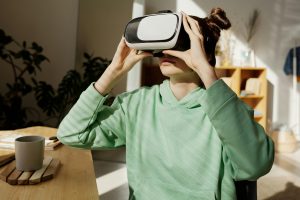In today’s digital-first world, brands are constantly seeking innovative ways to captivate audiences, and Augmented Reality Advertising (AR advertising) has emerged as a game-changer. With its ability to create immersive and interactive brand experiences, AR advertising goes beyond traditional marketing tactics to deeply engage consumers. But while engagement metrics like clicks, views, and dwell time are commonly used to measure success, they only scratch the surface.
To truly understand the impact of Augmented Reality Advertising, marketers need to look beyond engagement and adopt more advanced metrics. This article explores key performance indicators (KPIs) that offer deeper insights into AR advertising’s effectiveness, including emotional impact, brand recall, conversion rates, and long-term customer relationships.
Traditional Metrics in Augmented Reality Advertising
Before diving into advanced KPIs, let’s first review traditional engagement-based metrics commonly used in Augmented Reality Advertising campaigns:
Views & Impressions: The number of people who have seen the AR experience.
Click-through Rates (CTR): How many users interacted with a call-to-action (CTA) within the AR experience.
Dwell Time: The duration a user spends engaging with the AR content.
Social Shares: The number of times the AR experience is shared on social media.
While these metrics provide basic insight into campaign reach and interaction levels, they don’t necessarily indicate whether AR advertising influences consumer behavior or drives tangible business results. That’s where advanced metrics come in.
1. Emotional Impact: Understanding Consumer Reactions
One of the most powerful aspects of Augmented Reality Advertising is its ability to evoke strong emotional responses. Unlike traditional digital ads, AR experiences are immersive and can trigger excitement, curiosity, or even nostalgia.
How to Measure Emotional Impact:
Facial Recognition & Sentiment Analysis: Some brands use AI-driven sentiment analysis tools that analyze facial expressions while users interact with AR experiences.
Biometric Feedback: Eye-tracking and heart-rate monitoring can indicate levels of emotional engagement.
Surveys & Feedback Forms: Asking users about their emotional response post-interaction helps gauge how impactful the experience was.
Example:
A luxury fashion brand used AR to let users “try on” high-end accessories virtually. Using sentiment analysis, they discovered that customers who smiled while using the AR feature were 40% more likely to complete a purchase.
2. Brand Recall: Measuring Memory Retention
A great ad isn’t just seen—it’s remembered. AR’s immersive nature makes it a powerful tool for increasing brand recall, ensuring consumers retain brand messages long after the experience ends.
How to Measure Brand Recall:
Post-Interaction Surveys: Asking users about key elements of the campaign days or weeks later.
A/B Testing: Comparing recall rates between those who interacted with the AR experience and those who only saw traditional digital ads.
Eye-Tracking Studies: Analyzing how much attention consumers give to specific branding elements within the AR experience.
Example:
A beverage company ran an AR campaign where users could scan their bottles to unlock an animated story. A post-campaign survey found that users who engaged with the AR experience had a 65% higher recall of the brand message than those who only saw standard social media ads.
3. Conversion Rates: From Interaction to Purchase
Engagement is great, but real success lies in converting users into customers. AR can be highly effective at influencing purchase decisions, but measuring direct conversions requires strategic tracking.
How to Measure AR Conversion Rates:
Unique Promo Codes: Assign AR users a specific discount code and track redemption rates.
AR-Linked E-commerce Pages: Direct AR experiences to shoppable links and measure the traffic and sales.
Geofencing & In-Store Tracking: For AR campaigns tied to physical retail, use geofencing to measure how many users visit a store after engaging with AR content.
Example:
A cosmetics brand launched an AR-powered “try before you buy” campaign. By linking AR experiences to their e-commerce site with exclusive discounts, they saw a 35% increase in sales compared to traditional digital ads.
4. Long-Term Customer Relationships: Measuring Retention and Loyalty
The best marketing campaigns don’t just attract new customers—they foster loyalty. AR advertising can create memorable brand experiences that keep customers coming back.
How to Measure Long-Term AR Impact:
Customer Retention Rates: Track whether users who engaged with the AR experience return to purchase again.
Loyalty Program Sign-Ups: Measure how many AR users enroll in rewards programs or subscriptions.
Social Media Engagement Over Time: Monitor whether users continue to engage with the brand beyond the initial AR experience.
Example:
A fast-food chain introduced AR-powered collectible experiences for kids’ meals. Over six months, 70% of customers who interacted with the AR experience returned to purchase more meals featuring new collectibles.
Best Practices for Measuring Augmented Reality Advertising Success
To effectively measure the success of Augmented Reality Advertising, marketers should:
Define Clear Objectives: Whether it’s increasing sales, brand awareness, or customer retention, setting clear goals will help determine which metrics matter most.
Use Multi-Touch Attribution: Consumers may engage with AR content at multiple touchpoints before converting. Tracking their journey can reveal AR’s true influence.
Leverage AI & Data Analytics: Advanced tools like AI-driven sentiment analysis, heatmaps, and predictive analytics can offer deeper insights into AR performance.
Optimize Based on Insights: Regularly review performance data and refine AR experiences to improve results over time.






